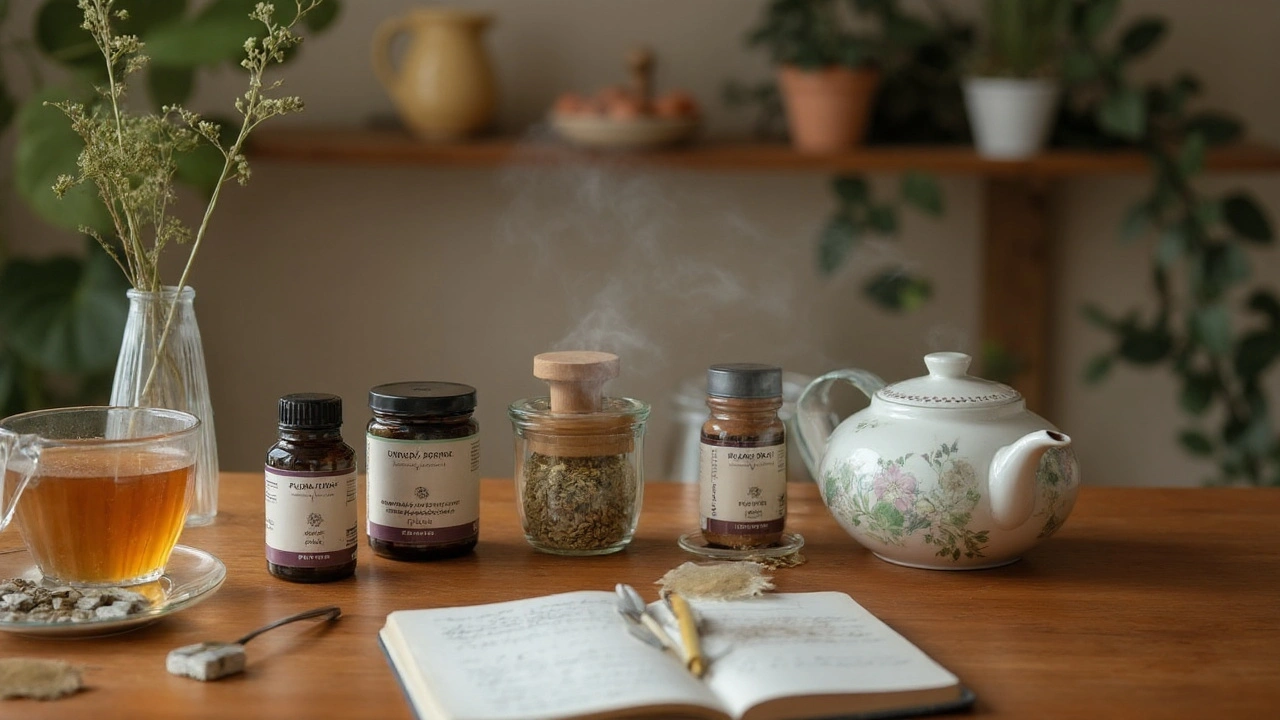If you’re wondering why so many people have started talking about Lukol, here’s the thing: as old-school medicine meets modern times, this little herbal remedy has gotten attention on social media, doctor’s blogs, and even at the checkout counter of high street wellness shops in the UK. It’s not some mysterious new import. Lukol, made by Himalaya Wellness, is an over-the-counter herbal supplement grounded in Ayurveda and favoured for supporting women’s reproductive health. The key question—does it actually do something, or is it just another bottle on a crowded shelf?
What Exactly is Lukol and What’s It Used For?
Ask around in South Asian communities and you’ll hear Lukol praised as a go-to remedy for “women’s problems.” What does that mean? Well, Lukol is an Ayurvedic medicine—a tablet packed with a blend of herbs like asparagus (Shatavari), banyan tree bark, Lodhra (Symplocos racemosa), and a few more that sound even trickier to pronounce. It’s usually marketed as a support for menstrual and reproductive health, with claims about balancing vaginal flora, easing irregular periods, and reducing discomfort linked to menstrual cycles. Mostly, it’s advertised for non-specific “white discharge” (leucorrhoea), mild infections, or just “toning” of the reproductive organs. Lukol’s not a hormone pill, and it doesn’t contain antibiotics or synthetic pharmaceutical ingredients. Instead, it banks on the ancient idea that natural herbs can help your body sort itself out.
The real draw? People are looking for options that don’t throw their hormones off-balance or come with a heavy side order of side effects. You’ll find stories of women who were fed up with endless cycles of antibiotics for chronic discharge, or with synthetic drugs that left them bloated, foggy, or just not themselves. The interest in Lukol spiked as traditional remedies landed a spot in mainstream health trends—a 2023 survey in London showed a 19% rise in herbal supplements for menstrual wellness compared to three years back, and Lukol sales climbed right along with that curve.
One specific appeal is how Lukol’s blend is supposed to tackle more than just one thing. It isn’t just about stopping white discharge; it aims to support uterine health, ease pelvic discomfort, and help regulate erratic cycles. It’s even been used as a gentle tonic after reproductive surgery or in periods of post-birth recovery. And for women who don’t want—or can’t take—estrogen or strong antibiotics, it’s a natural compromise that still feels proactive.
You’ll occasionally see it recommended for mild, recurrent vaginal infections, especially when you’re caught in the loop of a “not quite bad enough for more antibiotics” situation. It’s not a replacement for prescription medicine if your problem is serious or clearly infected, but for chronic, low-level issues, it has a following. Period doctors in Mumbai sometimes recommend it alongside probiotics and changes in hygiene, viewing it as part of a whole-body fix rather than a magic bullet.

The Ingredients, How Lukol Works, and What Science Really Says
If you flip the package over (or zoom into the online product photo), you’ll see a string of plant names. Shatavari is a superstar in Ayurveda, famous for “toning” female organs and said to help balance hormones or nourish the reproductive tract. Lodhra is thought to cool inflammation and reduce excessive bleeding (this is why it pops up in so many period-fix recipes in India). Himsra (capparis spinosa) and other lesser-known bark extracts round out the mix—claimed to possess antibacterial and anti-inflammatory effects. Lukol doesn’t mess around with concentrated extracts or lab-made molecules—it relies on tried-and-true dried herbs, ground and pressed into tablet form for daily use.
Now, is there rock-solid clinical proof? This is where it gets more interesting. Unlike many herbal remedies, Lukol actually does have a few small but real studies in peer-reviewed Indian journals. One 2019 trial included 50 women with chronic vaginal discharge—not linked to infections like thrush or BV but just persistent discomfort. After 8 weeks of Lukol use, 78% said their symptoms improved, and half stopped needing additional medication. Another randomized study, published in 2022, tested Lukol against a placebo for mild leucorrhoea: the Lukol group reported significantly fewer symptoms, though side effects and overall infection rates were about equal. Still, both studies were pretty small and didn’t have the huge sample sizes you’ll see in Western pharma trials. This doesn’t mean Lukol is snake oil—it just means expectations should be realistic, and it’s smart to use it alongside, not instead of, proper medical care.
On a more chemical level, Lukol’s makers explain that the herbs help reduce inflammation, tighten the lining of the uterus (think less spotting and easier recovery after periods or infections), and gently support the body’s natural barrier to bad bacteria. In plain English? It’s supposed to soothe, support, and strengthen, rather than force a strong artificial change. And since Lukol doesn’t have estrogen or strong antiseptics, the body isn’t thrown off in the way hormonal birth control or antibiotics can sometimes do.
If you care about interactions, Lukol has a low risk of clashing with other meds, though the research base isn’t huge. It’s usually taken as one or two tablets daily after meals, for a few weeks at a time. The routine is easy to stick with, which is worth a lot if you’re busy or tired of fiddly supplement schedules. One tip if you’re trying it: stick to the timeline. Lukol’s action is slow and steady, not a quick fix. Some women find it takes a full menstrual cycle to notice major changes, and it’s not a “take one and feel the difference” situation like popping a painkiller.

Practical Tips, Side Effects, and What to Watch Out For
If you’re thinking about adding Lukol to your routine, a few things are smart to keep in mind. First, it’s considered quite safe—that’s why you can buy it over the pharmacy counter in the UK, India, and much of Europe. Reports of side effects are low, but some women get bloating, a dry mouth, or mild digestive upsets at first. If you’re allergic to any of the herbs (people with sensitivities to asparagus, for example, should steer clear), it’s a no-go. And if you’re pregnant or breastfeeding, there’s not enough solid info to recommend using it—play it safe and give it a miss for now. Likewise, don’t use Lukol as your only line of defence if you’ve got obvious infections—pain, strong odour, fever, or heavy discharge needs real doctor attention, not just herbal backup.
For anyone with a complicated health background or on lots of medications, a quick word with your GP won’t hurt. Although there’s no known hassle when combining Lukol with most prescription drugs, new combinations always have some unknowns. Sticking to the suggested dose matters, too—it’s not a “the more, the better” kind of remedy. Going heavy could bring on an upset stomach or headaches, and doesn’t speed up the benefits either.
One tip that comes up often in women’s health forums: Lukol works best when you treat it as part of a bigger picture. If you’re facing recurrent vaginal discomfort or irregular periods, stack it with practical hygiene improvements—switch your pants for cotton, skip perfumed soaps, and focus on gut health with fermented foods or quality probiotics. In some cases, women who paired Lukol with gentle yoga or stress-busting habits like walking saw much steadier improvements. This seems to echo what Ayurvedic practice has always said: building small habits into a rhythm, rather than pinning all hopes on a pill, gives your body a better shot at bouncing back.
As for taste and texture, Lukol tablets aren’t sugar-coated or artificially sweetened. They’re a little bitter, and you’ll want to swallow them with water rather than try chewing. The good news? They’re small enough to pass unnoticed—no awkward “horse pill” vibes here. And unlike many “natural” products that come in expensive glass vials, Lukol remains pretty affordable—even at UK retail prices, you’re not shelling out luxury cash for a bottle and you don’t need a prescription.
Finally, if you’re the kind of person who likes reading anecdotal feedback before trying something new: women online describe everything from gradual symptom relief within two cycles to reduced cramping, less irregular bleeding, and a sense of “general balance.” No two stories are quite the same, and—here’s a real tip—if you haven’t seen positive change after a month, check in with a medical professional rather than ramping up the dose by yourself.
So, is Lukol the answer for everyone? No herbal blend can claim that. But for those searching for a gentler nudge towards women’s health—especially where regular medicine feels like too much or not enough—it offers a time-tested option with a low risk profile and plenty of user stories behind it. Just remember: as with anything in health, the smartest results come when you combine curiosity, common sense, and a willingness to listen to your body. If you’re ever unsure, the best tip is the oldest—ask your doctor, and trust your own comfort above all.


I am a pharmaceutical expert with over 20 years of experience in the industry. I am passionate about bringing awareness and education on the importance of medications and supplements in managing diseases. In my spare time, I love to write and share insights about the latest advancements and trends in pharmaceuticals. My goal is to make complex medical information accessible to everyone.